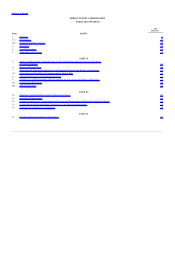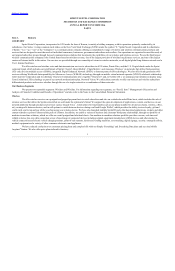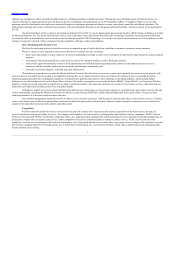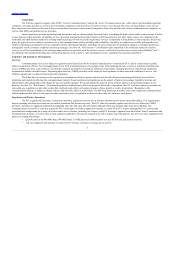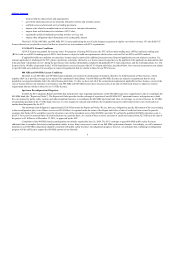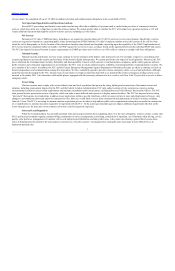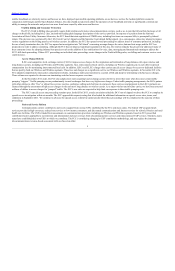Sprint - Nextel 2011 Annual Report Download - page 9
Download and view the complete annual report
Please find page 9 of the 2011 Sprint - Nextel annual report below. You can navigate through the pages in the report by either clicking on the pages listed below, or by using the keyword search tool below to find specific information within the annual report.
Table of Contents
Vision rollout. We completed all our of 1.9 GHz incumbent relocation and reimbursement obligations in the second half of 2010.
New Spectrum Opportunities and Spectrum Auctions
Several FCC proceedings and initiatives are underway that may affect the availability of spectrum used or useful in the provision of commercial wireless
services, which may allow new competitors to enter the wireless market. We cannot predict when or whether the FCC will conduct any spectrum auctions or if it will
release additional spectrum that might be useful to wireless carriers, including us, in the future.
911 Services
Pursuant to FCC rules, CMRS providers, including us, are required to provide enhanced 911 (E911) services in a two-tiered manner. Specifically, wireless
carriers are required to transmit to a requesting public safety answering point (PSAP) both the 911 caller's telephone number and (a) the location of the cell site from
which the call is being made, or (b) the location of the subscriber's handset using latitude and longitude, depending upon the capability of the PSAP. Implementation of
E911 service must be completed within six months of a PSAP request for service in its area, or longer, based on the agreement between the individual PSAP and carrier.
The FCC has imposed increased location accuracy requirements on CMRS providers and we believe we will be able to continue to comply with those obligations.
National Security
National security and disaster recovery issues continue to receive attention at the federal, state and local levels. For example, Congress is considering cyber
security legislation to increase the security and resiliency of the Nation's digital infrastructure. We cannot predict the cost impact of such legislation. Moreover, the FCC
has re-chartered the Communications Security, Reliability and Interoperability Council, which consists of communications companies, public safety agencies and non-
profit consumer and community organizations to recommend to the FCC ways to ensure optimal security, reliability, and interoperability of communications systems. We
are a member of the council. In addition, the FCC and the Federal Emergency Management Agency/Department of Homeland Security are likely to continue to focus on
disaster preparedness and communications among first responders. We have voluntarily agreed to provide wireless emergency alerts over our Sprint platform. Although
under the time line developed by the FCC, the provision of such alerts is to begin no later than April 2012, we launched the wireless emergency alerting system on our
network in November 2011. Our subscribers with mobile phones equipped with the necessary software who live, work or visit New York City are able to receive wireless
emergency alerts.
Tower Siting
Wireless systems must comply with various federal, state and local regulations that govern the siting, lighting and construction of transmitter towers and
antennas, including requirements imposed by the FCC and the Federal Aviation Administration. FCC rules subject certain cell site locations to extensive zoning,
environmental and historic preservation requirements and mandate consultation with various parties, including State and Tribal Historic Preservation Offices. The FCC
rules govern historic preservation review of projects, which can make it more difficult and expensive to deploy antenna facilities. The FCC has imposed a tower siting
“shot clock” that requires local authorities to address tower applications within a specific timeframe, which can assist carriers in more rapid deployment of towers. Any
changes to environmental protection and tower construction rules, however, would likely serve to delay construction and deployment of wireless systems, including
N
etwork Vision. The FCC is assessing its antenna structure registration process in order to help address public notice requirements when plans are made for construction
of, or modification to, antenna structures required to be registered with the FCC. To the extent governmental agencies impose additional requirements like this on the
tower siting process, the time and cost to construct cell towers could be negatively impacted.
State and Local Regulation
While the Communications Act generally preempts state and local governments from regulating entry of, or the rates charged by, wireless carriers, certain state
PUCs and local governments regulate customer billing, termination of service arrangements, advertising, certification of operation, use of handsets when driving, service
quality, sales practices, management of customer call records and protected information and many other areas. Also, some state attorneys general have become more
active in bringing lawsuits related to the sales practices and services of wireless carriers. Varying practices among the states may make it more difficult for us to
implement national sales
7


